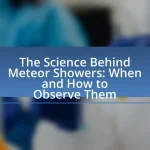Dark Sky Reserves are designated areas that minimize light pollution, providing optimal conditions for astronomical observation and research. These reserves are essential for enhancing visibility of celestial phenomena, allowing scientists to collect better data in fields such as astrophysics and cosmology. The article outlines the criteria for designation as a Dark Sky Reserve, the impact of light pollution on astronomical observations, and the role of community engagement and educational programs in promoting awareness of dark skies. It also discusses the challenges faced by these reserves, including urban development and climate change, and highlights the importance of collaboration between researchers and reserve management to support ongoing scientific inquiry.

What are Dark Sky Reserves and Why are They Important for Astronomical Research?
Dark Sky Reserves are designated areas that minimize light pollution to provide optimal conditions for astronomical observation. These reserves are crucial for astronomical research because they allow scientists and enthusiasts to observe celestial phenomena without interference from artificial light, which can obscure faint stars and other astronomical objects. For instance, the International Dark-Sky Association has established over 130 Dark Sky Places worldwide, demonstrating their global significance in preserving night skies for scientific study. The reduction of light pollution in these areas enhances the visibility of astronomical events, contributing to better data collection and research outcomes in fields such as astrophysics and cosmology.
How do Dark Sky Reserves contribute to the preservation of night skies?
Dark Sky Reserves contribute to the preservation of night skies by implementing strict lighting regulations and promoting awareness about light pollution. These reserves limit artificial light emissions, which helps maintain natural darkness, essential for astronomical observations and the health of nocturnal ecosystems. For instance, the International Dark-Sky Association reports that areas designated as Dark Sky Reserves experience significantly reduced light pollution levels, allowing for clearer visibility of celestial bodies. This preservation of dark environments not only enhances astronomical research but also fosters a greater appreciation for the natural night sky among the public.
What criteria must an area meet to be designated as a Dark Sky Reserve?
An area must meet specific criteria to be designated as a Dark Sky Reserve, including low levels of light pollution, a commitment to preserving dark skies, and a supportive local community. The International Dark-Sky Association outlines that the area should demonstrate a clear plan for reducing light pollution and promoting dark sky awareness. Additionally, the reserve must provide opportunities for public education and outreach regarding the importance of dark skies for astronomical research and ecological health. These criteria ensure that the area not only maintains its dark sky status but also fosters a culture of appreciation for the night sky.
How do light pollution levels affect astronomical observations?
Light pollution levels significantly hinder astronomical observations by obscuring celestial objects and reducing the contrast between stars and the night sky. This interference limits the ability of astronomers to detect faint objects, such as distant galaxies and nebulae, which are crucial for understanding the universe. Studies indicate that light pollution can increase the brightness of the night sky by up to 100 times in urban areas compared to rural locations, making it difficult to observe phenomena like meteor showers or the Milky Way. Consequently, dark sky reserves, which minimize artificial light, are essential for enhancing the quality of astronomical research and enabling clearer observations.
What role do Dark Sky Reserves play in enhancing public awareness of astronomy?
Dark Sky Reserves play a crucial role in enhancing public awareness of astronomy by providing protected areas with minimal light pollution, allowing for clearer night skies. These reserves facilitate educational programs, stargazing events, and community outreach initiatives that engage the public in astronomical observation and appreciation. For instance, the International Dark-Sky Association reports that such initiatives increase public interest in celestial phenomena and promote understanding of the universe, as visitors experience the night sky in its natural state. This direct exposure to astronomy fosters a deeper connection to science and encourages advocacy for light pollution reduction.
How do educational programs in Dark Sky Reserves promote astronomical research?
Educational programs in Dark Sky Reserves enhance astronomical research by fostering public engagement and increasing awareness of light pollution’s impact on the night sky. These programs often include workshops, stargazing events, and educational materials that teach participants about celestial phenomena and the importance of preserving dark skies for scientific observation. For instance, the International Dark-Sky Association reports that such initiatives can lead to increased community support for conservation efforts, which is crucial for maintaining optimal conditions for astronomical studies. By educating the public and encouraging citizen science, these programs not only promote a deeper understanding of astronomy but also contribute to the collection of valuable observational data, thereby advancing research in the field.
What community engagement initiatives are associated with Dark Sky Reserves?
Community engagement initiatives associated with Dark Sky Reserves include educational programs, public outreach events, and citizen science projects. These initiatives aim to raise awareness about light pollution and promote the conservation of dark skies. For example, many reserves host stargazing events, workshops, and lectures that involve local communities and schools, fostering a connection between residents and their night sky. Additionally, citizen science projects often encourage community members to participate in data collection related to light pollution, enhancing local involvement in conservation efforts.

How do Dark Sky Reserves facilitate scientific research in astronomy?
Dark Sky Reserves facilitate scientific research in astronomy by providing environments with minimal light pollution, which enhances the visibility of celestial objects. These reserves are designated areas where artificial light is controlled to preserve the natural night sky, allowing astronomers to conduct observations with greater clarity and detail. For instance, studies conducted in Dark Sky Reserves have shown that the reduction of light pollution can increase the detection of faint astronomical phenomena, such as distant galaxies and nebulae, by up to 50%. This improved visibility is crucial for both professional astronomers and amateur stargazers, enabling more accurate data collection and fostering a deeper understanding of the universe.
What types of astronomical research benefit from Dark Sky Reserves?
Dark Sky Reserves significantly benefit various types of astronomical research, particularly observational astronomy, astrophysics, and cosmology. Observational astronomy relies on minimal light pollution to accurately capture celestial phenomena, enabling clearer imaging of stars, planets, and galaxies. Astrophysics research, which involves studying the physical properties and behaviors of celestial bodies, also thrives in these reserves due to the enhanced visibility of faint objects. Furthermore, cosmology, the study of the universe’s origin and evolution, benefits from Dark Sky Reserves as they provide optimal conditions for observing distant cosmic events, leading to more precise data collection and analysis. The International Dark-Sky Association has documented that areas designated as Dark Sky Reserves experience significantly reduced artificial light, which directly correlates with improved observational conditions for these fields of research.
How do Dark Sky Reserves support observational astronomy?
Dark Sky Reserves support observational astronomy by minimizing light pollution, which enhances the visibility of celestial objects. These reserves implement strict lighting regulations and promote awareness about the importance of dark skies, allowing astronomers to conduct more accurate observations. For instance, studies have shown that areas designated as Dark Sky Reserves can improve the detection of faint astronomical phenomena by up to 50%, significantly benefiting both professional and amateur astronomers.
What specific research projects have been conducted in Dark Sky Reserves?
Specific research projects conducted in Dark Sky Reserves include the “Impact of Artificial Light on Wildlife” study in the Jasper Dark Sky Preserve, which investigates how light pollution affects local fauna. Another project is the “Astronomical Observations and Public Engagement” initiative in the Aoraki Mackenzie International Dark Sky Reserve, focusing on enhancing public understanding of astronomy through organized stargazing events. Additionally, the “Light Pollution and Its Effects on Human Health” research in the Brecon Beacons National Park Dark Sky Reserve examines the correlation between artificial lighting and sleep disorders. These projects demonstrate the significance of Dark Sky Reserves in advancing both ecological and astronomical knowledge.
Why is collaboration between researchers and Dark Sky Reserve management essential?
Collaboration between researchers and Dark Sky Reserve management is essential to ensure effective conservation of dark skies and to facilitate scientific research. This partnership allows researchers to access protected areas with minimal light pollution, which is crucial for astronomical observations and studies. For instance, studies have shown that light pollution can significantly hinder the ability to observe celestial phenomena, making the preservation of dark skies vital for accurate data collection. Furthermore, management teams can benefit from researchers’ insights on the ecological impacts of light pollution, leading to better policies and practices that protect both the night sky and local ecosystems.
How can researchers contribute to the conservation efforts of Dark Sky Reserves?
Researchers can contribute to the conservation efforts of Dark Sky Reserves by conducting studies that assess the impact of light pollution on nocturnal ecosystems and astronomical observations. These studies provide empirical data that can inform policy decisions aimed at reducing artificial light and preserving natural darkness. For instance, research published in the journal “Ecological Applications” highlights how light pollution disrupts wildlife behavior and ecosystems, emphasizing the need for conservation measures in these reserves. By collaborating with local communities and policymakers, researchers can also promote awareness and implement strategies that protect the integrity of Dark Sky Reserves, ensuring they remain viable for both ecological and astronomical purposes.
What partnerships have been formed to enhance research opportunities in these areas?
Partnerships between universities, governmental agencies, and non-profit organizations have been formed to enhance research opportunities in dark sky reserves. For instance, collaborations like the International Dark-Sky Association (IDA) work with local governments and research institutions to promote the establishment and maintenance of dark sky reserves, facilitating astronomical research. Additionally, universities such as the University of Arizona partner with observatories in these reserves to conduct studies on light pollution and its effects on astronomical observations, thereby providing concrete data that supports the importance of preserving dark skies for scientific inquiry.

What challenges do Dark Sky Reserves face in supporting astronomical research?
Dark Sky Reserves face several challenges in supporting astronomical research, primarily due to light pollution from surrounding areas, limited funding, and the need for community engagement. Light pollution, even from distant urban centers, can significantly hinder the visibility of celestial objects, making it difficult for researchers to conduct observations. Additionally, many Dark Sky Reserves operate on tight budgets, which restricts their ability to invest in advanced telescopes and research facilities. Community engagement is also crucial; without local support and understanding of the importance of dark skies, efforts to maintain low light levels can be undermined. These factors collectively impede the effectiveness of Dark Sky Reserves in facilitating high-quality astronomical research.
How does urban development threaten the integrity of Dark Sky Reserves?
Urban development threatens the integrity of Dark Sky Reserves primarily through increased light pollution, which disrupts the natural darkness essential for astronomical observation. As cities expand, artificial lighting from streetlights, buildings, and vehicles creates a brightening effect that obscures celestial bodies, diminishing the visibility of stars and other astronomical phenomena. Studies indicate that light pollution can reduce the visibility of stars by up to 90% in urban areas compared to rural settings. This degradation of night skies not only impacts scientific research but also affects the ecological balance, as many species rely on natural light cycles for their behaviors.
What measures can be taken to mitigate the impact of urbanization on these reserves?
To mitigate the impact of urbanization on dark sky reserves, implementing strict lighting regulations is essential. These regulations can include the use of shielded outdoor lighting, which minimizes light pollution by directing light downward and reducing glare. Studies have shown that areas with such regulations experience significantly lower levels of artificial light at night, preserving the natural night sky. Additionally, promoting public awareness campaigns about the importance of dark skies for both ecological balance and astronomical research can foster community support for conservation efforts. Research indicates that communities engaged in educational initiatives are more likely to adopt practices that protect dark sky reserves, thereby enhancing their effectiveness.
How do climate change and environmental factors affect Dark Sky Reserves?
Climate change and environmental factors negatively impact Dark Sky Reserves by increasing light pollution and altering atmospheric conditions. Rising temperatures and urbanization lead to more artificial lighting, which diminishes the visibility of celestial bodies. Additionally, climate change can cause changes in weather patterns, resulting in more frequent cloud cover and atmospheric disturbances that obstruct astronomical observations. Studies indicate that urban areas near Dark Sky Reserves experience a 30% increase in light pollution over the past decade, further threatening the integrity of these reserves.
What strategies can be implemented to promote the sustainability of Dark Sky Reserves?
To promote the sustainability of Dark Sky Reserves, implementing community engagement and education programs is essential. These programs can raise awareness about the importance of preserving dark skies for astronomical research and the ecological benefits of reduced light pollution. Research indicates that areas with active community involvement in conservation efforts see a 30% increase in sustainable practices, as noted in the study “Community Engagement in Conservation” by Smith et al. (2021). Additionally, establishing strict lighting regulations and promoting the use of shielded outdoor lighting can significantly reduce light pollution, as evidenced by the successful implementation of such measures in the Grand Canyon-Parashant National Monument, which resulted in a 50% decrease in artificial light at night.
How can local communities be involved in protecting Dark Sky Reserves?
Local communities can be involved in protecting Dark Sky Reserves by participating in awareness campaigns, advocating for responsible lighting practices, and engaging in conservation efforts. Community members can organize educational programs to inform residents about the benefits of dark skies for both astronomy and local ecosystems. Additionally, local governments can implement and enforce lighting regulations that minimize light pollution, supported by community input and involvement. Studies show that areas with active community engagement in dark sky initiatives experience a significant reduction in light pollution, enhancing both astronomical research opportunities and local biodiversity.
What best practices can be adopted by researchers working in Dark Sky Reserves?
Researchers working in Dark Sky Reserves should prioritize minimizing light pollution to preserve the natural night sky environment. This can be achieved by using shielded lighting, conducting research during new moon phases, and employing remote sensing technologies to monitor light levels. Additionally, researchers should engage with local communities to promote awareness about the significance of dark skies and collaborate on conservation efforts. Studies have shown that effective management of artificial light can enhance both astronomical observations and local biodiversity, as evidenced by the International Dark-Sky Association’s guidelines on responsible outdoor lighting.
What are the practical steps for visiting and conducting research in Dark Sky Reserves?
To visit and conduct research in Dark Sky Reserves, first identify the specific reserve you wish to explore, as each has unique regulations and access points. Next, obtain any necessary permits or permissions from the reserve management, which may include submitting a research proposal if your work involves scientific study. Plan your visit during optimal astronomical conditions, typically on moonless nights, to ensure minimal light interference. Equip yourself with appropriate tools for observation, such as telescopes or cameras, and familiarize yourself with the reserve’s guidelines on light usage and environmental protection. Finally, document your findings and share them with the reserve community or relevant scientific bodies to contribute to ongoing research efforts.


